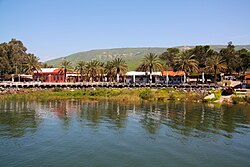Ein Gev
|
Ein Gev עֵין גֵּב |
|
|---|---|
 |
|
| Coordinates: 32°46′57.95″N 35°38′22.73″E / 32.7827639°N 35.6396472°ECoordinates: 32°46′57.95″N 35°38′22.73″E / 32.7827639°N 35.6396472°E | |
| District | Northern |
| Council | Emek HaYarden |
| Affiliation | Kibbutz Movement |
| Founded | 6 July 1937 |
| Population (2015) | 638 |
| Website | www.eingev.co.il |
Ein Gev (Hebrew: עֵין גֵּב) is a kibbutz in northern Israel. Located on the eastern shore of the Sea of Galilee near the ruins of the Greco-Roman settlement of Hippos, it falls under the jurisdiction of Emek HaYarden Regional Council. In 2015 its population was 638.
Kibbutz Ein Gev came into being on 6 July 1937 during the 1936–1939 Arab revolt in Palestine as a "" settlement, a common debut for many kibbutzim during that era, and quickly established itself as a viable community. The original settlers were immigrants from Czechoslovakia, Germany, Austria, and the Baltic countries. Using intensive cultivation methods, they developed banana plantations. They also fished the nearby Lake Kinneret (Sea of Galilee). By 1947 it had a population of 450.
Ein Gev pier, c 1947
Palmach members working at Ein Gev, before the 1948 war
Women from Yiftach Brigade working at Ein Gev. 1948
Situated along a border shared with Syria, Ein Gev was shelled during the Battles of the Kinarot Valley and in other engagements during the 1948 Arab–Israeli War. These dangers were only eliminated when Israel occupied the neighboring Golan Heights in the 1967 Six-Day War.
Near the present-day village an important archeological site from the mesolithic Kebaran culture has been excavated
The kibbutz operates a holiday resort and a fish restaurant. Agricultural branches include banana plantations and dairy farming. The kibbutz built a 2,500-seat concert hall to accommodate the Ein Gev Music Festival, held annually during Passover.
...
Wikipedia

